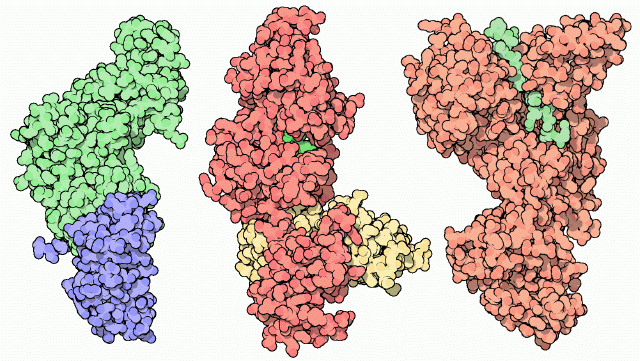|
Inhaltsübersicht | Nanomaschinen | Moleküle | Programme | Kurse | Fun | Links |
||
| > |
Anthrax Toxin
Anthrax is a household word, in spite of the fact that anthrax is not a common disease. For humans, anthrax is difficult to contract. It is not transmitted from person to person--it is usually contracted when people come into contact with infected animals or their products. But recently, anthrax has gained the potential to be a major threat through bioterrorism. It is an effective weapon because it forms sturdy spores that may be stored for years, that rapidly lead to lethal infections when inhaled.
A Lethal Combination
Anthrax is caused by an unusually large bacterium, Bacillus anthracis. Once its spores lodge in the skin or in the lungs, it rapidly begins growth and produces a deadly three-part toxin. These toxins are designed for maximum lethality, and are frighteningly effective. Part of the toxin is a delivery mechanism that seeks out cells; another part is a toxic enzyme that rapidly kills the cell. In anthrax toxin, there is one delivery molecule, termed "protective antigen" because of its use in anthrax vaccines (shown on the left from PDB entry 1acc). It delivers the other two parts, edema factor and lethal factor (center and right, from PDB entries 1k90 and 1jky), which are the toxic components that attack cells.Keeping Deadly Company
These types of multiple-part toxins are quite common in the bacterial world because they are exquisitely effective. Many other examples, such as toxins from the bacteria that cause cholera and whooping cough, may be found in the PDB. The delivery component specifically seeks out cell surfaces and inserts the toxic component where it can do the most damage.
The toxic component is far more effective than poisons like cyanide and arsenic. Those poisons attack one-on-one, with a single cyanide molecule poisoning a single protein molecule. But toxic enzymes are compact cell-killing machines. Once inside the cell, they hop from molecule to molecule, destroying each in turn. These molecules are so effective that in some cases a single molecule can kill an entire cell.
Next: Protective Antigen
Last changed by: A.Honegger,